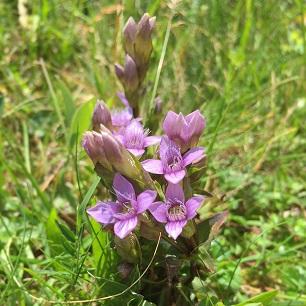Gentianella campestris
Field gentian

Fältgentiana in Swedish
The field gentian, Gentianella campestris is a strictly biennial herb that primarily occurs in semi-natural grasslands due to its dependence on consistent management (ie. grazing or mowing, Lennartsson 2000). It is one of six species of Gentianella in Sweden and occurs from Småland to Västerbotten and Jämtland (Naturhistoriska riksmuseet 1998, ArtDatabanken 2007).
The field gentian germinates in spring and forms a small rosette the first summer. It overwinters as a bud and a taproot and flowers in early July or mid August the following year, depending on phenologic variety (Lennartsson 2015, Wettenstein 1895 cited in Lennartsson et al. 1998). The flowers are bluish-purple or white, have four petals and produce around 500-1100 seeds (Lennartsson, 2015). The plant stem is about 5-20 cm high (ArtDatabanken 2007). The only known pollinator is bumblebees and the species has no vegetative propagation but it is highly selfing (Lennartsson and Oostermeijer 2001).
A study by Milberg (1994) showed that the species has a very short-lived seed bank and is therefore highly dependent on continuous seed production. Other studies have shown that grazing or mowing can have a positive impact on the reproduction of G. campestris as it induces overcompensation in the seed production (Lennartsson et al. 1997, 1998). However, grazing throughout the growing season may significantly increase the risk of extinction, compared to traditional management with mowing in July and autumnal grazing (Lennartsson & Oostermeijer 2001).
The species is strongly linked to nutrient poor, species-rich seminatural grasslands and can therefore serve as an indicator species (Lennartsson & Oostermeijer 2001, ArtDatabanken 2007). The Swedish red-list highlights loss of management as one of the main threats for the field gentian population (ArtDatabanken 2007). Loss of management can quickly affect the population as accumulating plant litter shades the seedlings and increases the mortality. This might be the factor that limits recruitment the most (Lennartsson & Oostermeijer 2001). Another effect of management loss is increased vegetation height, which in the summertime can hamper the rosette development (Lennartsson & Oostermeijer 2001).
References
Andrew Gelman and Yu-Sung Su (2015). arm: Data Analysis Using Regression and Multilevel/Hierarchical Models. R package version 1.8-6. http://CRAN.R-project.org/package=arm
ArtDatabanken (2007), Bengt Jonsell, Örjan Nilsson & Tommy Lennartsson 1992. Rev. Tommy Lennartsson 1998. Artfakta Gentianella campestris subsp. campestris http://artfakta.artdatabanken.se/taxon/221447 Accessed June 2015
ArtDatabanken (2015), Rödlistade arter i Sverige 2015. ArtDatabanken SLU, Uppsala. (In Swedish)
Bertilsson, A (1997) En ny metod för att övervaka miljöförändringar i ängs- och hagmarker. Länsstyrelsen i Skaraborg 97/13 (In Swedish)
Beaufoy, G., Baldock, D., Clark, J. (1994) The Nature of Farming: Low Intensity Farming Systems in Nine European Countries. Institute for European Environmental Policy, London
Ekstam, U & Forshed N (1996) Äldre fodermarker. Naturvårdsverket förlag. (In Swedish)
Eriksson, O & Kiviniemi K (1999) Site occupancy, recruitment and extinction thresholds in grassland plants: an experimental study. Biological Conservation 87:319-325
ESRI (2011) ArcGIS Desktop: Release 10. Redlands, CA: Environmental Systems Research Institute.
Fuller, R.M. (1987) The changing extent and conservation interest of lowland grasslands in England and Wales: a review of grassland surveys 1930-84. Biological Conservation 40:281-300
Hanski, I., (1994) A practical model of metapopulation dynamics. Journal of animal ecology, 63:151-162.
Hansson, M & Fogelfors H (2000) Management of a semi-natural grassland; results from a 15-year-old experiment in southern Sweden. Journal of Vegetation Science 11:31-38
Jordbruksverket (2008) Ängs- och betesmarker – en genomgång av tillgänglig statistik. Miljöenheten och Statistikenheten 2008:30 (In Swedish)
Jordbruksverket (2010) Instruktion för fältinventering av brukarblock, version 5. OVR159-5 (In Swedish)
Jordbruksverket (2014) Sveriges ängs- och betesmarker har inventerats (in Swedish): https://www.jordbruksverket.se/amnesomraden/miljoklimat/ettriktodlingslandskap/angsochbetesmarksinventering.4.207049b811dd8a513dc80003958.html Accessed in Jan 2016
Lennartsson, T. (2000). Management and population viability of the pasture plant Gentianella campestris: the role of interactions between habitat factors.Ecological bulletins 48:111-121.
Lennartsson, T (2002) Extinction thresholds and disrupted plant-pollinator interactions in fragmented plant populations. Ecology, 83:3060-3072
Lennartsson, T (2015) Åtgärdsprogram för fältgentianor i naturliga fodermarker, 2015-2019. Naturvårdsverket rapport 6681. (In Swedish)
Lennartsson, T., Nilsson, P., & Tuomi, J. (1998). Induction of overcompensation in the field gentian, Gentianella campestris. Ecology, 79:1061-1072.
Lennartsson, T., & Oostermeijer, J. G. B. (2001). Demographic variation and population viability in Gentianella campestris: effects of grassland management and environmental stochasticity. Journal of Ecology, 89:451-463.
Lennartsson, T., & Svensson, R. (1996). Patterns in the decline of three species of Gentianella (Gentianaceae) in Sweden, illustrating the deterioration of semi-natural grasslands. Symbolae Botanicae Upsaliensis. 31:170-184.
Lennartsson, T., Tuomi, J., & Nilsson, P. (1997). Evidence for an evolutionary history of overcompensation in the grassland biennial Gentianella campestris (Gentianaceae). The American Naturalist, 149:1147-1155.
Lindborg, R. & Eriksson, O. (2004) Historical landscape connectivity affects present plant species diversity. Ecology, 85:1840-1845
Milberg, P. (1994). Germination ecology of the endangered grassland biennial Gentianella campestris. Biological Conservation, 70:287-290.
Naturhistoriska riksmuseet (1998) Gentianellor. Den virtuella floran. (In Swedish) http://linnaeus.nrm.se/flora/di/gentiana/genta/welcome.html Accessed in June 2015
Pain, D.J., Pienkowski, M.W. (1997) Farming and Birds in Europe: The Common Agricultural Policy and Its Implications for Bird Conservation. Academic Press, Cambridge
Pannekoek J. and Van Strien, A. (2001). TRIM 3 Manual. (TRends and Indices for Monitoring data). Research paper no. 0102. Statistics Netherlands, Voorburg.
Pettersson M. (2004). Hur går det för gentianorna? Gentianella amarella och G. campestris i Uppland 1992 och 2003. Sveriges Lantbruksuniversitet nr. 124 (In Swedish)
Pykälä J. (2003) Effects of restoration with cattle grazing on plant species composition and richness of semi-natural grasslands. Biodiversity and Conservation, 12:2211-2226
Pöyry J., Luoto M., Paukkunen J., Pykälä J., Raatikainen K., Kuussaari M. (2006) Different responses of plants and herbivore insects to a gradient of vegetation height: an indicator of the vertebrate grazing intensity and successional age. OIKOS, 115:401-412
R Core Team (2014). R: A language and environment for statistical computing. R Foundation for Statistical Computing, Vienna, Austria. http://www.R-project.org/ Accessed in February 2016
Svensson, B., Lagerlöf J, Svensson B.G. (2000) Habitat preferences of nest-seeking bumble bees (Hymenoptera: Apidae) in an agricultural landscape. Agriculture, Ecosystems & Environment, 77:247-255
Öckinger, E. and Smith, H.G., (2007) Semi‐natural grasslands as population sources for pollinating insects in agricultural landscapes. Journal of applied ecology, 44:50-59.
Responsible for this page:
Director of undergraduate studies Biology
Last updated:
06/27/18
